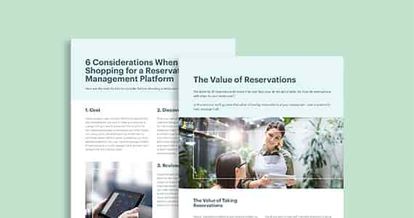Only two things in life are certain: death and taxes. So yes, your restaurant will pay taxes. (But it won’t die, because you won’t let it!)
As a business owner, you’ll need to know which restaurant taxes you’ll pay, when you’ll pay them, and how to file them. You’ll also need to know enough about payroll taxes to make sure you’re deducting enough from your staff members’ paychecks – and maybe give your serving staff a little advice on how to report on their tips during tax season.
You’ll walk away from this section knowing more about:
- Income tax reporting by business type
- Payroll taxes
- Sales tax
- Restaurant taxes on tips
- When and how to pay restaurant taxes
While restaurant taxes may seem like a daunting subject, we’re here to put your anxiety to rest and tell you exactly what you need to know about taxes as a business owner. At the end of this section you’ll have the language and knowledge you need to competently discuss restaurant taxes with your accountant, who can advise you on any benefits you may be eligible for based on the particulars of your business.
Income Taxes by Business Type
The income tax you pay as a business owner will depend on your legal structure. Sole proprietors, for instance, file all business income tax on their personal tax return and don’t need to file a separate business tax return. Corporations, however, are more closely regulated by governments and therefore must file a business tax return.
Learn more about registering your restaurant as a business.
Here’s what you need to know about Restaurant tax rates and reporting for each business structure.
Sole proprietorship
U.S.
Sole proprietors own an unincorporated business that does not require a separate income tax return. The Internal Revenue Service (IRS) has put together a chart to help sole proprietors determine which personal income tax forms they need to file as a business owner.
Federal income tax has seven brackets depending on income level and filing status: 10%, 15%, 25%, 28%, 33%, 35%, and 39.6%. See these charts for more information.
Forms that will most likely apply to you as a restaurant owner include:
- 1040, U.S. Individual Income Tax Return (your personal income tax return)
- Schedule C (Form 1040), Profit or Loss from Business
- Schedule C-EZ (Form 1040), Net Profit from Business
- Schedule SE (Form 1040), Self-Employment Tax
- 941, Employer’s Quarterly Federal Tax Return
- 940, Employer’s Annual Federal Unemployment (FUTA) Tax Return
- W-2, Wage and Tax Statement (for each employee)
Sole proprietors need to pay what’s called “estimated taxes”; as a restaurant owner, you will need to make estimated tax payments, as you can expect to owe $1,000 or more in taxes of when your return is filed. Use Form 1040-ES to figure out your estimated tax.
Canada
As a sole proprietor, you’ll pay taxes by reporting your income (or loss) on a T1 income tax and benefit return for the Canada Revenue Agency (CRA). You’ll also use Form T2125, Statement of Business or Professional Activities to report your business income and expenses.
The federal tax rate on personal income is:
- The first $45,282 = 15% tax rate
- The next $45,281 = 20.5% tax rate
- The next $49,825 = 26% tax rate
- The next $59,612 = 29% tax rate
- Income over $200,000 = 33% tax rate
You’ll also need to file taxes with your province or territory. See this chart for tax rates for each region.
Partnerships
U.S.
Partnerships as a business entity do not file income tax returns with the IRS. Good news, right?
But they do file what’s called an “information return” that reports the business partnership’s income, deductions, gains, losses, etc. Then, similar to sole proprietor businesses, income tax reporting must be “passed through” each partner, who includes their share of the business’ income or loss on their tax return.
Federal income tax has seven brackets depending on income level and filing status: 10%, 15%, 25%, 28%, 33%, 35%, and 39.6%. See these charts for more information.
If your business is a partnership, here’s what you’ll need to file with the IRS:
- 1040, U.S. Individual Income Tax Return (your personal income tax return)
- 1065, U.S. Return of Partnership Income
- Schedule E (Form 1040), Supplemental Income and Loss
- Schedule SE (Form 1040), Self-Employment Tax
- 944, Employer’s Annual Federal Tax Return
- 940, Employer’s Annual Federal Unemployment (FUTA) Tax Return
- 1040-ES, Estimated Tax for Individuals
Note that partners are not employees and should not be issued form W-2, Wage and Tax Statement. Instead your partnership will need to give copies of Schedule K-1 within Form 1065 to the partners.
Canada
A business that’s set up as a partnership doesn’t file an income tax return as an entity. Similar to a sole proprietorship, each partner includes a share of the partnership income (or loss) on their personal income tax return, and they file Form T5013, Statement of Partnership Income. You’ll need to mail two copies of the T5013, Statement of Partnership Income to the last known address of each partner.
The federal tax rate on personal income is:
- The first $45,282 = 15% tax rate
- The next $45,281 = 20.5% tax rate
- The next $49,825 = 26% tax rate
- The next $59,612 = 29% tax rate
- Income over $200,000 = 33% tax rate
You’ll also need to file taxes with your province or territory. See this chart for tax rates for each region.
Partnerships must send the Canada Revenue Agency (CRA) the following:
- Form T5013 FIN, Partnership Financial Return
- Form T5013SUM, Summary of Partnership Income
- Original copy of all slips T5013, Statement of Partnership Income
- Form T5013 SCH 1, Net Income (Loss) for Income Tax Purposes (Schedule 1)
- Form T5013 SCH 50, Partner’s Ownership and Account Activity (Schedule 50)
- Form T5013 SCH 100, Balance Sheet Information (Schedule 100)
- Form T5013 SCH 125, Income Statement Information (Schedule 125)
- Form T5013 SCH 141, Financial Statement Notes Checklist (Schedule 141)
- One copy of the notes to the financial statements for the fiscal period
Corporation
U.S.
A corporation is subject to the same deductions as a sole proprietorship, but the profit of a corporation is subject to a double tax: it’s taxed to the corporation when it’s earned, and it’s taxed to shareholders when you distribute it as dividends. Note that your corporation wouldn’t get a tax deduction on dividends to shareholders.
Tax rates for corporations are:
| Taxable income ($) | Tax rate (%) |
| 0 to 50,000 | 15% |
| 50,000 to 75,000 | $7,500 + 25% of the amount over 50,000 |
| 75,000 to 100,000 | $13,750 + 34% of the amount over 75,000 |
| 100,000 to 335,000 | $22,250 + 39% of the amount over 100,000 |
| 335,000 to 10,000,000 | $113,900 + 34% of the amount over 335,000 |
| 10,000,000 to 15,000,000 | $3,400,000 + 35% of the amount over 10,000,000 |
| 15,000,000 to 18,333,333 | $5,150,000 + 38% of the amount over 15,000,000 |
| 18,333,333 and up | 35% |
You can refer to this chart to help you determine which forms you’ll need to file, but here’s what you’ll most likely need to file with the IRS:
- 1120, U.S. Corporation Income Tax Return (see Instructions for Form 1120 U.S. Corporation Income Tax Return)
- 1120-W Estimated Tax for Corporations
- Schedule E (Form 1040), Supplemental Income and Loss
- Schedule SE (Form 1040), Self-Employment Tax
- 941, Employer’s Quarterly Federal Tax Return
- 940, Employer’s Annual Federal Unemployment (FUTA) Tax return
Canada
The basic corporate tax rate is:
- 38% of your taxable income
- Minus a federal tax abatement of 10%
- Minus a general tax reduction of 13% on qualifying income
- Net tax rate for a corporation = 15%
- But for corporations that claim the small business deduction, the net tax rate = 10.5%
Then there are lower and higher rates for each province and territory that have corporation tax collection agreements with the CRA (Alberta and Quebec do not). The lower rate applies to corporations that qualify for the small business deduction. See this chart for lower and higher rates in each province and territory.
As a corporation in Canada, you will need to file either a:
- T2 Corporation Income Tax Return: an eight-page return that can be used by any corporation OR
- T2 Short Return: a two-page return plus three schedules. See Guide T4012, T2 Corporation Income Tax Guide to check if you are eligible to use this return.
You’ll need to file your return no later than six months after the end of each tax year. The tax year of a corporation is its fiscal period. So, for example, if your tax year ends March 31, your filing due date is September 30.
Payroll Taxes for Restaurants
Payroll taxes fall into two categories: deductions from your employees’ wages and the taxes you pay as an employer based on your employees’ wages. Here we’ll cover both based on where your business is located.
U.S.
Before we discuss the payroll taxes you withhold from your employees’ paychecks, we’ll cover the charges you need to pay to cover your staff’s Social Security, Medicare, and Federal Unemployment taxes.
You’ll need to pay the following payroll taxes as an employer:
- Social Security: 12.4% of your staff wages up to a maximum of $118,500 (for a maximum contribution of $14,694 in 2016), half imposed on you and half withheld from your staff’s pay
- Medicare: 2.9% of staff wages, half imposed on you and half withheld from your staff’s pay
- Federal Unemployment (FUTA) Tax: 6% applicable to the first $7,000 you paid to each employee for the year
When you report on your income tax as a sole proprietor, partnership, or corporation, you’ll need to file the following:
- 941, Employer’s Quarterly Federal Tax Return
- 940, Employer’s Annual Federal Unemployment (FUTA) Tax Return
- W-2, Wage and Tax Statement (for each employee)
Canada
Businesses in Canada pay several payroll taxes, including Canada Pension Plan and Employment Insurance.
- Canada Pension Plan: 4.95% of your employees’ wages/salary (will increase to 5.95% by 2019)
- Employment insurance: your contribution is 1.4x the amount you deduct from your employees’ wages/salary (see the Payroll Deductions Online Calculator for your rate)
Use the Payroll Deductions Online Calculator to determine your federal, provincial (except for Quebec), and territorial payroll deductions.
You’ll also need to withhold a portion of your employees’ wages to ensure they are paying the appropriate amount of tax. Most locations are governed by withholding formulas based on how much money each employee makes. Here’s where you can find all the information you need to withhold payroll taxes in certain locations.
New York
New York’s withholding method is based on a formula. See this document to calculate your withholding taxes.
You can send your New York – New Jersey Waterfront payroll taxes and quarterly Form WC-30 to:
Waterfront Commission of New York Harbor
39 Broadway, 4th Floor
New York, NY 100064
212-742-9280
Chicago
You must register with Illinois Revenue to withhold Illinois Income Tax.
For more information on withholding tax amounts, see Booklet IL-700-T.
Other documents to review are:
- 2017 Illinois Withholding Income Tax Payment and Return Due Dates
- 2017 Withholding Income Tax Changes
- 2017 Common Withholding Income Tax Errors
Toronto
Use the Payroll Deductions Online Calculator to calculate federal, provincial (except for Quebec), and territorial payroll deductions.
Other documents to review are:
- T4127, Payroll Deductions Formulas for Computer Programs
- T4001, Employers’ Guide – Payroll Deductions and Remittances
Sales Tax
As a new business owner, you should be aware of the sales tax rates in your city, state, and/or province.
Sales tax is “a consumption tax imposed by the government on the sale of goods and services.” So every time your restaurant makes a sale, there will be a tax associated with each purchase. You will need to know the sales tax rate for your area so you can effectively program your point of sale to add the appropriate amount to each order.
Here are the sales tax rates for certain regions.
New York
For food and beverages sold by restaurants and caterers in New York City:
- City Sales Tax rate is 4.5%
- New York State Sales and Use Tax is 4%
- Metropolitan Commuter Transportation District surcharge is 0.375%
- Total Sales and Use Tax in New York City = 8.875%
Chicago
In Illinois, “sales tax” refers to several tax acts. For restaurants that sell what’s considered “general merchandise”, the sales tax rate is 6.25%. Then, depending on the zipcode, the sales tax rate of Chicago varies from 6.3% to 10.25%.
Combined rates are made up of:
- Illinois state rate is 6.25%
- County rate is 1.75%
- Chicago tax rate is 1% to 1.25%
- In some cases, there is a special rate of 1%
Use the Chicago sales tax calculator for exact rates.
Toronto
In Toronto, Ontario, there is a “Harmonized Sales Tax” of 13% on all purchases. The Harmonized Sales Tax is made up of 8% of an Ontario portion of sales tax and 5% of federal sales tax (known before as GST).
Note: First Nations Status Indians, Indian bands, and councils of Indian bands are eligible for a point of sale exemption from paying the 8% Ontario portion of the HST for qualifying off-reserve purchases.
Taxes on Tips
For front-of-house staff who are serving customers, it’s all about the tips. Tips are the real bread and butter for servers, not the wages that are paid and taxed and reported to the government.
Many servers have personal rules for reporting their tips during tax season. Some use the “10% rule” in that they only claim 10% of their gratuities as income on their personal tax return. Some don’t view their tips as taxable income at all – and in some ways, you may not blame them. If you’ve worked in the restaurant industry, you know it can be difficult to earn a living wage and understand the inner conflict that arises every year during tax season.
But as an employer, you should know the rules for reporting tips so that you’re providing staff with the information they need to make decisions about their own taxes. While reporting gratuities as taxable income is a controversial topic, here’s what you need to know so you can provide neutral, accurate information to your employees.
U.S.
In the United States, the Fair Labor Standards Act (FLSA) defines tipped employees as “those who routinely make more than $30 per month in tips above their regular wages. … Restaurant employees such as waiters or bartenders routinely receive more than $30 per month in tips, classifying them as tipped employees who can then be paid a lower hourly rate.”
So herein lies the controversy for many: if your servers make more than $30 in tips – and let’s hope they will! – they may receive a wage that is lower than minimum wage and need to claim all of their tips as taxable income. This is controversial because tips are an unpredictable source of income. But the rule is such that if your service staff make more than $30 per month in tips, they must claim all of their tips as taxable income.
Not only that, but your employees are responsible for tracking tips and reporting them to you, who is then responsible for reporting and paying into the Federal Insurance Contributions Act (FICA) and state income taxes on behalf of the employee. Keep in mind that if an hourly employee receives only an occasional tip and doesn’t meet the $30 requirement, then you don’t need to report their gratuities.
Canada
Canadian taxpayers are required to report all tips on their personal tax returns, but there are several ways they may be reported based on whether they are “controlled tips” or “direct tips”.
Controlled tips
Controlled tips are what you as an employer add to customers’ bills to cover gratuities (say, for large parties where there is automatic gratuity added) or shared tips as part of a tip pool that then get paid out to employees later.
The Canada Revenue Agency (CRA) considers these tips as paid to the employee by you, the employer, which means you need to list these earnings on box 14 of your employee’s T4 slip; these earnings are subject to Canada Pension Plan and Employment Insurance payroll deductions. This also means that these tips do not need to be claimed elsewhere by the employee on their personal income tax return.
Direct tips
Direct tips are ones that are paid to the employee by the customer, and they can be cash, pooled tips controlled by employees, or tips that are made via debit or credit card.
CPP and EI are not deducted from direct tips through payroll, but an employee can choose to make CPP contributions on tip income by filling out form CPT20. Direct tips are declared on line 104 on their personal tax returns.
Note that the CRA expects all tips to be reported as an exact number, not an estimate. The CRA recommends that servers save 25% of their tips to cover their taxes.
As an employer, you aren’t required to keep a record of your employees’ direct tips.
Conclusion
No matter the government in power, taxes will always be a reality for small businesses, including restaurants. You should now be equipped with the knowledge you need to competently navigate the world of income tax, payroll taxes, sales tax, and taxes on tips.
When tax season rolls around, however, make sure to talk to a skilled tax expert who can advise you on details that may save you money. Your government may have released a new tax deduction that applies to your business, and you’ll want to make sure you know about it so you’re not paying too much tax when you don’t have to.





